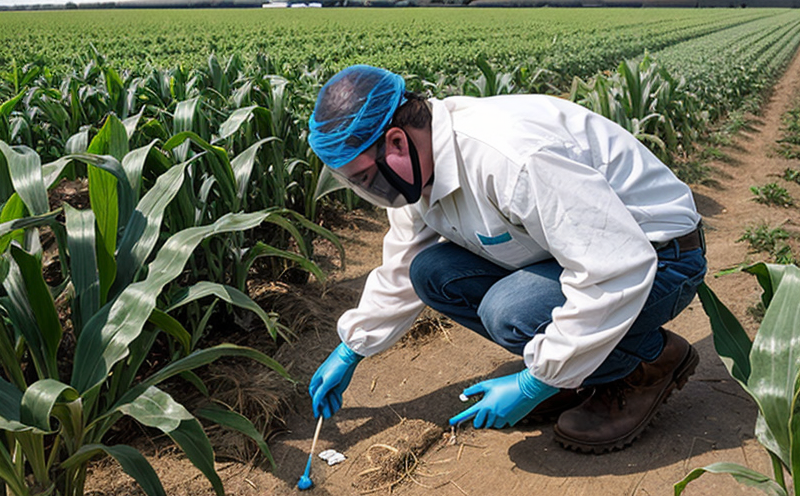Cypermethrin Residue Testing in Crops
The need to ensure food safety and environmental protection has never been more crucial. Cypermethrin is a widely used synthetic pyrethroid insecticide that provides effective pest control but poses potential risks if not managed properly. Consequently, rigorous residue testing for cypermethrin in crops is essential to meet regulatory standards and safeguard public health.
Our laboratory specializes in providing comprehensive pesticide residue analysis services, focusing on detecting traces of cypermethrin in various agricultural products. This service ensures that producers and importers comply with international standards such as the World Health Organization’s (WHO) guidelines for maximum residue levels (MRLs). Our expertise lies in offering accurate, reliable, and timely results to support your quality assurance processes.
The testing process involves several critical steps: sample collection, extraction, purification, quantification using advanced analytical techniques like Liquid Chromatography-Tandem Mass Spectrometry (LC-MS/MS), and data interpretation. Each step is meticulously conducted following stringent protocols to guarantee precision and accuracy in the final results.
Compliance with regulatory frameworks such as the Codex Alimentarius, EU Regulations, and U.S. FDA guidelines ensures that our findings are recognized globally. For instance, the Codex Alimentarius sets MRLs for cypermethrin at 0.1 ppm for fruits like apples and oranges, while stricter limits apply to leafy vegetables. Adhering to these standards helps us provide actionable insights into your product’s safety profile.
Our team of experienced chemists employs state-of-the-art instrumentation to achieve the lowest detection limits possible. Modern LC-MS/MS technology offers high sensitivity, selectivity, and reliability, making it an ideal choice for detecting even minute quantities of cypermethrin residues in complex matrices such as vegetables, grains, or fruits.
The importance of this service cannot be overstated. Not only does it protect consumers from harmful exposure to pesticides but also enhances the reputation of your brand by demonstrating a commitment to responsible agricultural practices. By partnering with us, you gain access to robust testing capabilities that contribute significantly towards maintaining food safety standards and fostering trust among end-users.
Our dedicated professionals are committed to delivering top-notch service tailored specifically for your unique requirements. Whether you require routine monitoring or one-off assessments, we offer flexible solutions designed around your schedule. With our advanced methodologies and commitment to excellence, you can rest assured knowing that every sample processed undergoes rigorous scrutiny until accurate results emerge.
For more detailed information about the specific procedures involved in cypermethrin residue testing, please consult our technical documentation or contact us directly for personalized advice. Together, let's work towards ensuring the integrity of your agricultural operations and contributing positively to global food security efforts.
Scope and Methodology
The scope of cypermethrin residue testing encompasses a wide range of crops including fruits, vegetables, grains, and other plant materials where this insecticide might be applied. Our laboratory adheres strictly to internationally recognized standards such as ISO 17025 for proficiency in method validation and quality assurance.
The methodology involves several key stages:
- Sample Preparation: Properly collecting representative samples from the field or storage facilities is crucial. Samples must be free from contamination, stored appropriately, and transported under controlled conditions to prevent degradation.
- Extraction: Using appropriate solvents and extraction techniques ensures that all potential residues are released into the solution for further processing.
- Purification: Removing unwanted components through filtration or chromatographic methods enhances the purity of the extract before analysis.
- Analysis: Advanced analytical instruments like LC-MS/MS enable precise measurement of cypermethrin levels down to parts per billion (ppb).
- Data Interpretation: Comparing measured values against established MRLs allows determination whether residues exceed acceptable limits.
Throughout this process, we maintain strict adherence to predefined protocols ensuring reproducibility and consistency across all tests conducted. This approach guarantees that clients receive reliable data upon which they can base informed decisions regarding their production processes or supply chain management practices.
Industry Applications
Cypermethrin residue testing plays a vital role in multiple sectors beyond just agriculture and forestry:
- Agricultural Supply Chains: Ensuring compliance with international regulations helps build trust within global trade networks.
- Food Processing Industries: Minimizing contamination risks throughout processing stages ensures safer end products reaching consumers.
- Government Agencies: Monitoring pesticide usage patterns aids in formulating effective policies governing sustainable practices and public health protection.
In addition to these sectors, research institutions may also utilize our services for studying long-term impacts of cypermethrin exposure on ecosystems or human health. By leveraging accurate residue data, researchers can contribute valuable insights into best management strategies moving forward.
Quality and Reliability Assurance
At [Your Lab Name], we pride ourselves on maintaining the highest standards of quality assurance throughout our testing processes. Our commitment to excellence is reflected in multiple ways:
Certification Compliance: We are accredited by leading bodies such as ISO 17025, demonstrating our capability to perform high-quality laboratory tests consistently.
Continuous Improvement Initiatives: Regular audits and reviews help identify areas for enhancement ensuring continuous improvement in service delivery.
Trained Technicians: Our staff undergo rigorous training programs to stay updated with the latest developments in analytical techniques and best practices.
Advanced Equipment: Investment in cutting-edge instrumentation guarantees accurate measurements even when dealing with extremely low concentrations of residues.
We understand that trust is earned through consistent performance over time. Therefore, we maintain detailed records of every test performed along with supporting documentation to ensure transparency and accountability. Should any discrepancies arise during future inspections or audits, our comprehensive audit trails facilitate swift resolution without compromising integrity.





